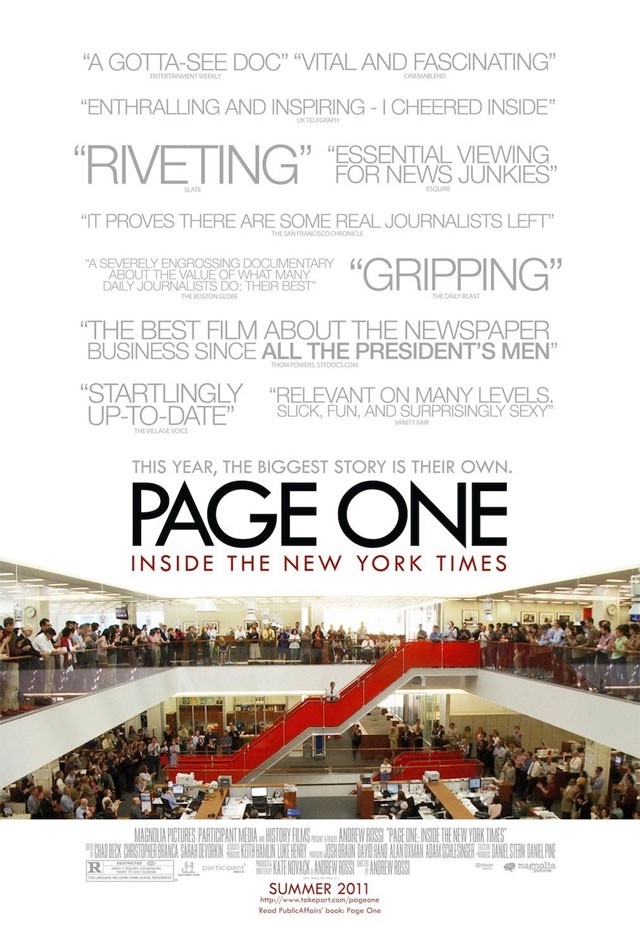“You have lived through the worst cyclical recession the publishing business has ever seen in modern times,” New York Times media columnist and culture reporter David Carr tells the attendees at a publishing conference in his Minneapolis, Minn., hometown toward the end of director Andrew Rossi’s compelling documentary Page One: Inside the New York Times. They’re in what looks like a hotel meeting space; it’s one of the smaller conference rooms. “Look around you, you’re still here. Don’t think about the people that are gone. Think about the people that made it. It’s a really big deal. It demonstrates, No. 1, that you are a bunch of tenacious motherfuckers, I’ll tell you that. You have proven you cannot be killed.”
Over the course of Page’s 88 minutes, Carr emerges as its de facto focus: He’s old-school journalism’s dogged pugilist who still has a number of good jabs in him, verbally dressing down Vice editors and newser.com mouthpiece Michael Wolff while simultaneously being an ideal representative of the necessary growing pains the Times had to endure in order to survive in the 21st century’s new-media landscape. For roughly one year, 2009-10, Rossi and his camera were granted impressive access to the Times’ newsroom, particularly its media desk: editor Bruce Headlam; reporters Tim Arango, Richard Pérez-Peña, and Brian Stelter; and columnist Carr. This period, as Carr acknowledges above, coincided with an often-devastating drop in print advertising, leading to layoffs and buyouts throughout all aspects of American journalism, including the Times.
At the same time, the Gray Lady was trying to shape-shift and handle stories and sourcing issues brought on by this constantly changing new-media scrum: the emergence of Julian Assange’s WikiLeaks with the Afghan war logs and the eventual Times partnership (along with The Guardian and Der Spiegel) with the activist-journalism hybrid, NBC Universal’s merger with Comcast, the release of the iPad and the reconsideration of paywalls for online news content, and, via Carr, the reprehensible corporate culture at the Tribune Co. (the Baltimore Sun’s parent) that contributed to its bankruptcy. The colorful Carr is the perfect human story to anchor Page’s peek behind the scenes of an ink-on-paper news institution learning how to stand up and tweet in the digital age. As the doc lets him confess, Carr is the former New Journalism devotee, drug addict, and single parent on welfare who has performed a career metamorphosis to become one of the Times’ better-known online names, thanks to his Carpetbagger blog and a very active Twitter feed. Still, there’s something about Carr, with his smoker’s rasp and no-BS attitude, speaking at the Minneapolis publishing conference that feels a tad like actor Warren Oates in The Wild Bunch motivating who’s left before a Mexican warlord’s henchmen gun them down.
If there’s any nagging issue with the engaging Page, it’s a preaching-to-the-choir-to-get-it-to-sing patina. It’s difficult to imagine anybody still employed in journalism — or people who are just news junkies — not being seduced by its arc of a newspaper and its journalists fighting the good fight of tracking down sources, fact-checking narratives, possessing healthy skepticism, and trying to speak truth to power. That’s what newspapers are supposed to do. That’s what Rossi captures the wonderfully even-keeled editor Headlam doing: listening to his reporters, constantly asking questions, making sure all the “i”s are dotted, and taking those calls from people who are trying to stop stories from going forward. That’s what newspapers have always done, as Page alludes to in interviews with Gay Talese (the former Times writer and author of 1969’s The Kingdom and the Power: Behind the Scenes at The New York Times: The Institution That Influences the World), a discussion of Daniel Ellsberg and the Pentagon Papers, and interviews with former Washington Post Watergate scandal reporter Carl Bernstein. And in such company, Page offers yet another glowing argument for why traditional journalism matters: Reporters write history’s first draft, warts and all, and no single person can do that by him/herself.
Page is less successful at reaching those not already on the news-matters boat: Nothing in it is going to convince a devoted news-aggregator consumer that traditional news has an inherent value that isn’t free. More problematic, Page’s discussion about publishing’s imperiled business model in a print-versus-web culture are familiar and, like most discussions of it even right now, speculative and partial, if only because nobody has outlined the plan that’s going to work.
These question marks sometimes lend the documentary a vacillating tone: You suspect Page feels it’s telling a story of a minor victory in an ongoing campaign (it concludes with then-Times Executive Editor Bill Keller announcing 2010 Pulitzer finalists to the newsroom) while at the same time a tad unsure just how the paper is going to fare in the long war. Page opens with a sequence of an issue of the Times being made — the same big rolls of newsprint heading to the presses and finished copies being loaded onto trucks that formed the nostalgic coda to 2009’s State of Play, whose undertow was the end of traditional print journalism. Only Carr, ever incredulous, appears to consider the unthinkable: a world without traditional shoe-leather journalism. In the scene preceding his presentation to the conference, Rossi’s camera catches Carr talking candidly about his appearance as he drives there: “We’re just going to gather around the campfire and say, ‘We’re all right — aren’t we? Are we OK?’”
Page One: A Year Inside the New York Times
Dir. Andrew Rossi; writ. Kate Novack, Andrew Rossi; feat. David Carr, Carl Bernstein, Bruce Headlam. (R)


